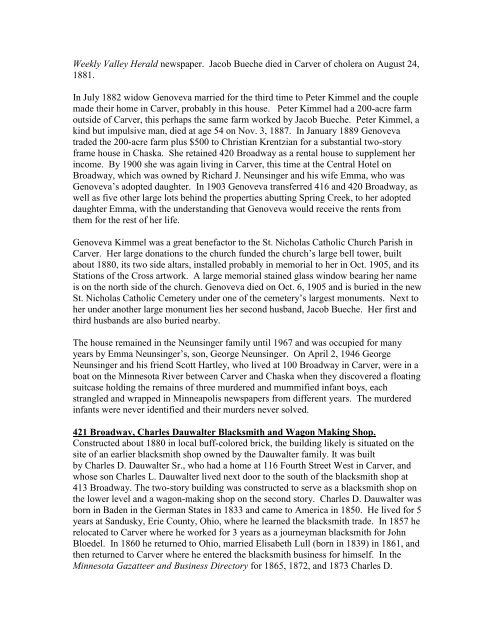Historic Homes and Businesses in Carver - Carver County Historical ...
Historic Homes and Businesses in Carver - Carver County Historical ...
Historic Homes and Businesses in Carver - Carver County Historical ...
You also want an ePaper? Increase the reach of your titles
YUMPU automatically turns print PDFs into web optimized ePapers that Google loves.
Weekly Valley Herald newspaper. Jacob Bueche died <strong>in</strong> <strong>Carver</strong> of cholera on August 24,<br />
1881.<br />
In July 1882 widow Genoveva married for the third time to Peter Kimmel <strong>and</strong> the couple<br />
made their home <strong>in</strong> <strong>Carver</strong>, probably <strong>in</strong> this house. Peter Kimmel had a 200-acre farm<br />
outside of <strong>Carver</strong>, this perhaps the same farm worked by Jacob Bueche. Peter Kimmel, a<br />
k<strong>in</strong>d but impulsive man, died at age 54 on Nov. 3, 1887. In January 1889 Genoveva<br />
traded the 200-acre farm plus $500 to Christian Krentzian for a substantial two-story<br />
frame house <strong>in</strong> Chaska. She reta<strong>in</strong>ed 420 Broadway as a rental house to supplement her<br />
<strong>in</strong>come. By 1900 she was aga<strong>in</strong> liv<strong>in</strong>g <strong>in</strong> <strong>Carver</strong>, this time at the Central Hotel on<br />
Broadway, which was owned by Richard J. Neuns<strong>in</strong>ger <strong>and</strong> his wife Emma, who was<br />
Genoveva‟s adopted daughter. In 1903 Genoveva transferred 416 <strong>and</strong> 420 Broadway, as<br />
well as five other large lots beh<strong>in</strong>d the properties abutt<strong>in</strong>g Spr<strong>in</strong>g Creek, to her adopted<br />
daughter Emma, with the underst<strong>and</strong><strong>in</strong>g that Genoveva would receive the rents from<br />
them for the rest of her life.<br />
Genoveva Kimmel was a great benefactor to the St. Nicholas Catholic Church Parish <strong>in</strong><br />
<strong>Carver</strong>. Her large donations to the church funded the church‟s large bell tower, built<br />
about 1880, its two side altars, <strong>in</strong>stalled probably <strong>in</strong> memorial to her <strong>in</strong> Oct. 1905, <strong>and</strong> its<br />
Stations of the Cross artwork. A large memorial sta<strong>in</strong>ed glass w<strong>in</strong>dow bear<strong>in</strong>g her name<br />
is on the north side of the church. Genoveva died on Oct. 6, 1905 <strong>and</strong> is buried <strong>in</strong> the new<br />
St. Nicholas Catholic Cemetery under one of the cemetery‟s largest monuments. Next to<br />
her under another large monument lies her second husb<strong>and</strong>, Jacob Bueche. Her first <strong>and</strong><br />
third husb<strong>and</strong>s are also buried nearby.<br />
The house rema<strong>in</strong>ed <strong>in</strong> the Neuns<strong>in</strong>ger family until 1967 <strong>and</strong> was occupied for many<br />
years by Emma Neuns<strong>in</strong>ger‟s, son, George Neuns<strong>in</strong>ger. On April 2, 1946 George<br />
Neuns<strong>in</strong>ger <strong>and</strong> his friend Scott Hartley, who lived at 100 Broadway <strong>in</strong> <strong>Carver</strong>, were <strong>in</strong> a<br />
boat on the M<strong>in</strong>nesota River between <strong>Carver</strong> <strong>and</strong> Chaska when they discovered a float<strong>in</strong>g<br />
suitcase hold<strong>in</strong>g the rema<strong>in</strong>s of three murdered <strong>and</strong> mummified <strong>in</strong>fant boys, each<br />
strangled <strong>and</strong> wrapped <strong>in</strong> M<strong>in</strong>neapolis newspapers from different years. The murdered<br />
<strong>in</strong>fants were never identified <strong>and</strong> their murders never solved.<br />
421 Broadway, Charles Dauwalter Blacksmith <strong>and</strong> Wagon Mak<strong>in</strong>g Shop.<br />
Constructed about 1880 <strong>in</strong> local buff-colored brick, the build<strong>in</strong>g likely is situated on the<br />
site of an earlier blacksmith shop owned by the Dauwalter family. It was built<br />
by Charles D. Dauwalter Sr., who had a home at 116 Fourth Street West <strong>in</strong> <strong>Carver</strong>, <strong>and</strong><br />
whose son Charles L. Dauwalter lived next door to the south of the blacksmith shop at<br />
413 Broadway. The two-story build<strong>in</strong>g was constructed to serve as a blacksmith shop on<br />
the lower level <strong>and</strong> a wagon-mak<strong>in</strong>g shop on the second story. Charles D. Dauwalter was<br />
born <strong>in</strong> Baden <strong>in</strong> the German States <strong>in</strong> 1833 <strong>and</strong> came to America <strong>in</strong> 1850. He lived for 5<br />
years at S<strong>and</strong>usky, Erie <strong>County</strong>, Ohio, where he learned the blacksmith trade. In 1857 he<br />
relocated to <strong>Carver</strong> where he worked for 3 years as a journeyman blacksmith for John<br />
Bloedel. In 1860 he returned to Ohio, married Elisabeth Lull (born <strong>in</strong> 1839) <strong>in</strong> 1861, <strong>and</strong><br />
then returned to <strong>Carver</strong> where he entered the blacksmith bus<strong>in</strong>ess for himself. In the<br />
M<strong>in</strong>nesota Gazatteer <strong>and</strong> Bus<strong>in</strong>ess Directory for 1865, 1872, <strong>and</strong> 1873 Charles D.


